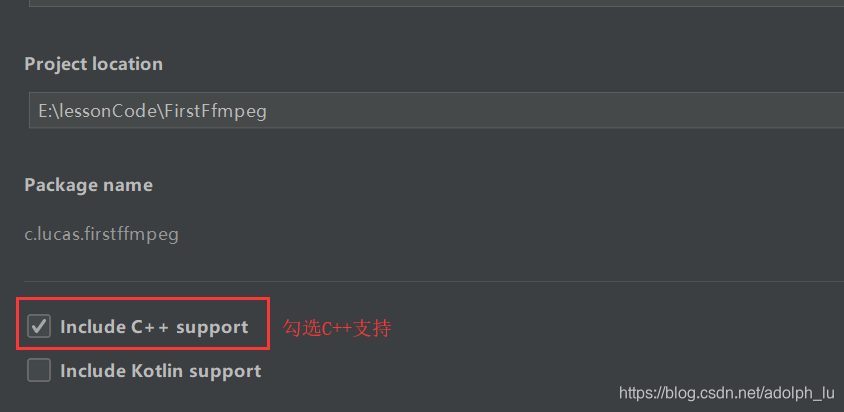版权声明:本文为博主原创文章,未经博主允许不得转载。 https://blog.csdn.net/adolph_lu/article/details/90477243
AndroidStudio版本3.2
1.创建Android项目
1.1打开AndroidStudio,创建一个名为FirstFfmpeg的项目,勾选C++支持
1.2 minimun SDK选择5.0,4.0或者4.1都可以,根据自身项目需求
1.3 C++ Standard 选择C++11
1.4等待Android项目创建完成
为了方便查看Android文件目录,可以将Android视图结构切换为Project

2.导入已经编译好的ffmpeg头文件和库文件
2.1导入ffmpeg库头文件:复制编译好的ffmpeg的动态库中的头文件到app目录下
2.2导入ffmpeg动态库文件:在app/libs下新建armeabi-v7a文件夹,将动态库复制到该目录下
3.编写CMakeLists.txt文件,Android会默认生成这个文件,我们只需要修改即可,如下,添加的地方都有详细的注释,相信都能看得懂
# For more information about using CMake with Android Studio, read the
# documentation: https://d.android.com/studio/projects/add-native-code.html
# Sets the minimum version of CMake required to build the native library.
cmake_minimum_required(VERSION 3.4.1)
# Creates and names a library, sets it as either STATIC
# or SHARED, and provides the relative paths to its source code.
# You can define multiple libraries, and CMake builds them for you.
# Gradle automatically packages shared libraries with your APK.
#添加头文件目录,相对于CMakeLists.txt也就是本文件的路径,从目录
#结构中可以看出,CMakeLists.txt和include目录是在同一级目录
include_directories(include)
#设置ffmpeg库所在路径的变量 FF为表示路径的变量,
#CMAKE_CURRENT_SOURCE_DIR为CMake内置变量,表示CMakeLists所在的目录
#ANDROID_ABI CPU架构类型,如果gradle文件没有设置过滤,
#则会表示所有的架构,arm-v7a arm-v8a x86 x86_64
#所以FF=CMAKE_CURRENT_SOURCE_DIR/libs/armeabi-v7a
set(FF ${CMAKE_CURRENT_SOURCE_DIR}/libs/${ANDROID_ABI})
#添加avcodec SHARED表示动态库 IMPORTED表示从外部导入
add_library(avcodec SHARED IMPORTED)
set_target_properties(avcodec PROPERTIES IMPORTED_LOCATION ${FF}/libavcodec.so)
#avformat
add_library(avformat SHARED IMPORTED)
set_target_properties(avformat PROPERTIES IMPORTED_LOCATION ${FF}/libavformat.so)
add_library( # Sets the name of the library.
native-lib
# Sets the library as a shared library.
SHARED
# Provides a relative path to your source file(s).
src/main/cpp/native-lib.cpp)
# Searches for a specified prebuilt library and stores the path as a
# variable. Because CMake includes system libraries in the search path by
# default, you only need to specify the name of the public NDK library
# you want to add. CMake verifies that the library exists before
# completing its build.
find_library( # Sets the name of the path variable.
log-lib
# Specifies the name of the NDK library that
# you want CMake to locate.
log)
# Specifies libraries CMake should link to your target library. You
# can link multiple libraries, such as libraries you define in this
# build script, prebuilt third-party libraries, or system libraries.
#将添加进来的库avcodec avformat链接到native-lib库中,
#因为我们最终只会生成一个libnative-lib.so库
#这个库如果没有指定路径,那么可以在app/build/cmake/debug/obj中找到
target_link_libraries( # Specifies the target library.
native-lib
avcodec avformat
# Links the target library to the log library
# included in the NDK.
${log-lib})
4在native-lib.cpp中添加avcodec.h头文件,调用avcodec_configuration()打印ffmpeg configure参数
#include <jni.h>
#include <string>
//ffmpeg是基于C语言的库,所以在使用ffmpeg的头文件的时候,需要用extern来标记
extern "C"
{
#include <libavcodec/avcodec.h>
}
extern "C" JNIEXPORT jstring JNICALL
Java_c_lucas_firstffmpeg_MainActivity_stringFromJNI(
JNIEnv *env,
jobject /* this */) {
std::string hello = "Hello from C++";
//avcodec_configuration()返回ffmpeg配置参数
hello += avcodec_configuration();
return env->NewStringUTF(hello.c_str());
}
5.修改app下build.gradle,主要是设置只编译armeabi-v7a架构,设置ffmpeg动态库目录
defaultConfig {
applicationId "c.lucas.firstffmpeg"
minSdkVersion 21
targetSdkVersion 28
versionCode 1
versionName "1.0"
testInstrumentationRunner "android.support.test.runner.AndroidJUnitRunner"
externalNativeBuild {
cmake {
cppFlags "-std=c++11"
}
//只编译armeabi-v7a架构
ndk {
abiFilters "armeabi-v7a"
}
}
//设置ffmpeg动态库目录 相对于app下的build.gradle文件目录
sourceSets{
main{
jniLibs.srcDirs=['libs']
}
}
}
6.最后编译运行,可以在手机屏幕上看到ffmpeg的编译配置信息。
